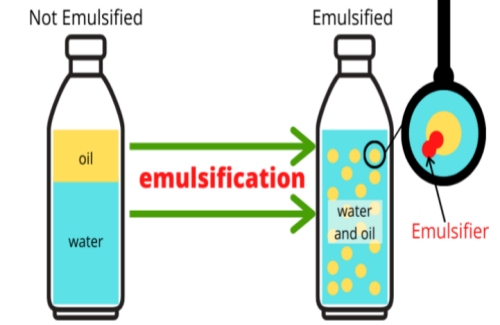Future Advancements in Emulsifier In Food Technology
Find out Exactly How an Emulsifier in Food Can Help Achieve Completely Blended Dishes Each Time
Emulsifiers are important active ingredients in the culinary globe, allowing the mixing of oil and water-based elements. Their ability to decrease surface area tension permits the development of stable blends, enhancing both appearance and flavor in different dishes. Comprehending just how these compounds feature can transform the method one comes close to cooking. Numerous stay unaware of the different kinds of emulsifiers and their details applications. Exploring this topic discloses valuable insights for attaining culinary perfection.
What Are Emulsifiers and Exactly How Do They Function?
Emulsifiers play a necessary role in the food market by making it possible for the stable mixing of components that typically do not combine, such as oil and water. These compounds have both hydrophilic (water-attracting) and hydrophobic (water-repelling) buildings, allowing them to engage with both sorts of ingredients. When an emulsifier is included in a combination, it lowers the surface tension between the oil and water, assisting in the formation of tiny droplets of one fluid distributed within the various other. This process produces a secure emulsion, stopping separation gradually and improving structure and mouthfeel. Emulsifiers are basic in various food, from salad dressings to ice lotions, making certain consistency and high quality. They likewise add to the total sensory experience of food, affecting taste launch and aesthetic allure. Comprehending just how emulsifiers operate is essential for food researchers and cooks alike, as they endeavor to create enjoyable and well balanced cooking experiences.
Typical Sorts Of Emulsifiers Used in Food Preparation
Many types of emulsifiers are utilized in food preparation to accomplish desired structures and stability in numerous food. Typical emulsifiers consist of lecithin, which is normally found in egg yolks and soybeans, and is extensively utilized in mayonnaise and dressings. An additional common emulsifier is mustard, which consists of compounds that aid blend oil and water in sauces.
In addition, business emulsifiers such as mono- and diglycerides are commonly contributed to refined foods to improve their security and improve service life. Starch-based emulsifiers, stemmed from corn or potatoes, are additionally utilized in sauces and puddings for enlarging and appearance. Casein, a milk protein, serves as an emulsifying representative in milk items like cheese and lotion. Each of these emulsifiers plays a crucial function in making certain that components blend perfectly, giving the preferred uniformity and flavor in cooking productions.
The Science Behind Emulsification

The security of a solution counts on the balance between the pressures acting upon the spread droplets. If the droplets integrate, the solution can break, resulting in separation. Numerous variables, such as temperature level, concentration of the emulsifier, and the method of blending, affect the success of emulsification. Comprehending this scientific foundation is crucial for attaining constant cause cooking applications including emulsions.
Tips for Using Emulsifiers in Your Dishes
When integrating emulsifiers into dishes, cautious consideration of their residential or commercial properties and functionality can greatly boost the end product. Initially, one ought to pick the proper emulsifier based on the wanted structure and stability of the meal. Emulsifier In Food. Common alternatives include lecithin, mustard, and egg yolks, each offering one-of-a-kind benefits
It's necessary to comprehend the temperature level at which the emulsifier works ideal; for example, some emulsifiers work successfully at room temperature level, while others require warmth. Gradually including oil to the emulsifier while whisking can assist develop a stable solution.
In addition, the ratio of emulsifier to liquid is important; insufficient may result in separation, while too much can produce an unwanted texture. Ultimately, appropriate storage space conditions ought to be thought about, as some emulsified products may need refrigeration to preserve stability and quality. By complying with these ideas, cooks can accomplish constantly well-blended recipes.

Delicious Recipes Featuring Emulsifiers
While lots of cooks might not understand it, including emulsifiers right into dishes can raise meals to new heights of taste and appearance. A traditional vinaigrette benefits substantially from the enhancement of mustard, which acts as an emulsifier, offering a smooth consistency that binds oil and vinegar flawlessly. In a similar way, homemade mayonnaise showcases the power of egg yolks, creating a luscious, extravagant sauce ideal for sandwiches and salads.
In cooking, emulsifiers like lecithin can assist achieve a tender web link crumb in muffins and cakes, enhancing dampness retention. A rich delicious chocolate ganache, made with heavy lotion and chocolate, can also integrate an emulsifier to maintain a smooth finish. In addition, gelato usually use emulsifiers to guarantee a luscious texture and stop ice crystal formation, leading to a fascinating dessert experience. By incorporating these emulsifying agents, cooks can develop dishes that thrill the taste and offer an enjoyable mouthfeel.
Frequently Asked Concerns
Are Emulsifiers Safe for People With Food Allergies?
Emulsifiers can be risk-free for people with food allergic reactions, relying on the particular emulsifier utilized. Nonetheless, cross-reactivity and individual sensitivities differ; subsequently, speaking with a health care specialist is advisable to ensure security.
Can I Make My Very Own Emulsifier in the house?
Yes, people can official source develop homemade emulsifiers using ingredients like egg yolks, mustard, or honey. These natural options can efficiently blend oils and water-based elements, using a basic remedy for numerous culinary applications.
How Do Emulsifiers Affect the Nutritional Value of Food?
Emulsifiers can enhance the nutritional value of food by improving nutrient absorption and stability. However, too much intake might bring about damaging results, possibly changing food digestion procedures and influencing digestive tract health and wellness in sensitive individuals.


Are There Any Kind Of Unfavorable Negative Effects of Consuming Emulsifiers?
Some research studies recommend that consuming emulsifiers might lead to intestinal concerns or disrupt intestine microbiota balance. Additional study is required to completely recognize their long-term effects on health and wellness and possible negative side effects.
Can Emulsifiers Modification the Taste of My Dishes?
Emulsifiers can discreetly alter the flavor profile of dishes. By boosting texture and mouthfeel, they may make flavors a lot more obvious or well balanced, but they usually do not convey solid preferences by themselves.
Emulsifiers play an essential function in the food market by allowing the steady blending of active ingredients that commonly do not combine, such as oil and water. Numerous types of emulsifiers are utilized in cooking to achieve desired textures and stability in various food products. Additionally, commercial emulsifiers such as mono- and diglycerides are often added to refined foods to boost their security and boost rack life. It's necessary to recognize the temperature level at which the pop over to this web-site emulsifier works finest; for instance, some emulsifiers work effectively at room temperature level, while others call for warm (Emulsifier In Food). Emulsifiers can be risk-free for individuals with food allergies, depending on the details emulsifier made use of